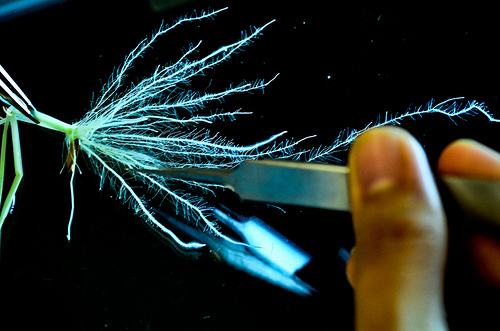
A close-up of roots that can increase grain production by drawing more phosphorus (source: www.irri.org)
Singapore: Scientists at the International Rice Research Institute, headquartered in the Philippines, have pinpointed a gene in an Indian variety of rice that enables rice plants to produce around 20 percent more grain by increasing uptake of phosphorus, an important but limited plant nutrient. The discovery unlocks the potential to improve food security with the lowest value phosphorus-deficient land. It will allow them to grow more rice to add to global production and earn more.
The discovery was published in the science journal Nature. The gene, PSTOL1, stands for Phosphorus Starvation Tolerance and helps rice grow a larger, better root system and thereby access more phosphorus.
Farmers can apply phosphorus fertilizers to increase productivity but on problem soils phosphorus is often locked in the soil and unavailable to plants. Also, phosphorus fertilizer is often unaffordable to poor farmers. Adding to the problem is that phosphorus is a non-renewable natural resource and rock phosphate reserves - the source of most phosphorus fertilizers - are running out.
"For many years we have searched for genes that improve phosphorus uptake," said Dr Sigrid Heuer, senior scientist at the International Rice Research Institute (IRRI) and leader of the team that published the discovery in Nature. "We've known for a long time that the traditional rice variety Kasalath from India has a set of genes that helps rice grow well in soils low in phosphorus."
Kasalath's superior performance under phosphorus deficiency was initially discovered by Dr Matthias Wissuwa from the Japan International Research Center for Agricultural Sciences. He then started collaborating with the IRRI and shared the DNA information of Kasalath. The current research was supported and facilitated by the CGIAR Generation Challenge Program.
"We have now hit the jackpot and found PSTOL1, the major gene responsible for improved phosphorus uptake and understand how it works," Dr Heuer said.
According to Dr Wricha Tyagi at the School of Crop Improvement at the Central Agricultural University in the Indian state of Meghalaya, knowledge of the exact gene will be critical for future breeding programs suited to Eastern and North-Eastern parts of India where rice productivity is less than 40 percent of the national average due to acidic soil and poor availability of phosphorus.
The discovery of the PSTOL1 gene means that rice growers will be able to breed new rice varieties faster and more easily, and with 100 percent certainty their new rice will have the gene. Dr Joko Prasetiyono of the Institute for Agricultural Biotechnology and Genetic Resources Research and Development in Indonesia is breeding rice plants with the PSTOL1 gene. The plants are not genetically modified but bred using smart modern breeding techniques.
"In field tests in Indonesia and the Philippines, rice with the PSTOL1 gene produced about 20 percent more grain than rice without the gene," said Dr Heuer. "In our pot experiments," she added, "when we use soil that is really low in phosphorus, we see yield increases of 60 percent and more, suggesting it will be very effective in soils low in phosphorus, such as in upland rice fields that are not irrigated and where farmers are often very poor."
The PSTOL1 gene is also being tested in rice varieties for the more productive irrigated rice-growing areas and initial results show that the plants grow a better root system and have higher production too. This means it could help farmers in these areas reduce their fertilizer use and expenditure without compromising productivity.
The discovery also demonstrates the importance of conserving the genetic diversity of traditional crop varieties such as Kasalath. IRRI conserves more than 114,000 different types of rice in the International Rice Genebank.
The group of rice (the aus-type) that Kasalath is part of is also the source of the submergence tolerance gene, which IRRI has used to breed submergence-tolerant New rice varieties with the enhanced capacity to take up phosphorus may be available within a few years to farmers.




